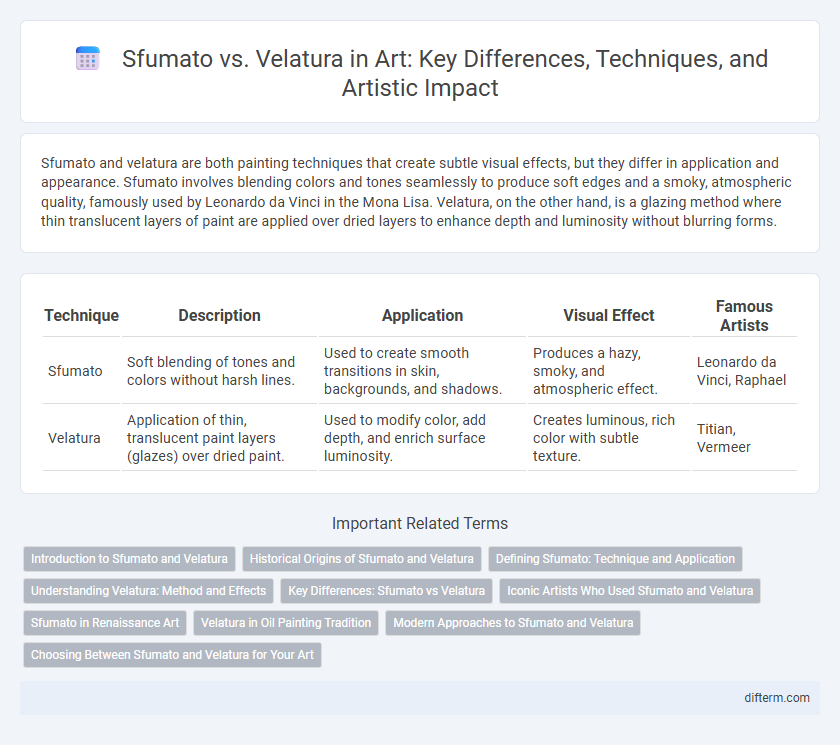Sfumato and velatura are both painting techniques that create subtle visual effects, but they differ in application and appearance. Sfumato involves blending colors and tones seamlessly to produce soft edges and a smoky, atmospheric quality, famously used by Leonardo da Vinci in the Mona Lisa. Velatura, on the other hand, is a glazing method where thin translucent layers of paint are applied over dried layers to enhance depth and luminosity without blurring forms.
Table of Comparison
| Technique | Description | Application | Visual Effect | Famous Artists |
|---|---|---|---|---|
| Sfumato | Soft blending of tones and colors without harsh lines. | Used to create smooth transitions in skin, backgrounds, and shadows. | Produces a hazy, smoky, and atmospheric effect. | Leonardo da Vinci, Raphael |
| Velatura | Application of thin, translucent paint layers (glazes) over dried paint. | Used to modify color, add depth, and enrich surface luminosity. | Creates luminous, rich color with subtle texture. | Titian, Vermeer |
Introduction to Sfumato and Velatura
Sfumato, a Renaissance painting technique pioneered by Leonardo da Vinci, creates soft transitions between colors and tones by blending layers of pigment to produce a hazy, smoky effect. Velatura involves applying semi-transparent glazes over a dry layer of paint, enhancing depth and luminosity without obscuring underlying details. Both techniques manipulate light and shadow to enrich the visual texture and dimensionality of artworks.
Historical Origins of Sfumato and Velatura
Sfumato, developed during the Italian Renaissance, was famously perfected by Leonardo da Vinci and involves subtle gradations of tone and color to create a smoky, blurred effect enhancing realistic depth. Velatura originated in the Baroque period and employs thin translucent layers of paint to modify underlying colors, intensifying luminosity and richness without obscuring details. Both techniques reflect evolving artistic priorities: sfumato emphasizes atmospheric depth and softness, while velatura focuses on vibrant color modulation and texture refinement.
Defining Sfumato: Technique and Application
Sfumato is a Renaissance painting technique characterized by the delicate blending of colors and tones, creating soft transitions without harsh lines or borders. It achieves a smoky, atmospheric effect, enhancing depth and realism by simulating the subtle gradations of light and shadow on surfaces, often seen in Leonardo da Vinci's works. This method contrasts with velatura, which uses thin, transparent layers of paint to modify underlying colors, whereas sfumato focuses on seamless, almost imperceptible shading to replicate natural visual experience.
Understanding Velatura: Method and Effects
Velatura is a painting technique involving the application of transparent, tinted glazes to create depth and subtle shifts in color, enhancing luminosity and realism. Unlike sfumato, which softens edges to produce a smoky, blurred effect, velatura builds layers that modify color tones without losing underlying details. This method allows artists to achieve rich, shimmering surfaces and intricate tonal gradations critical for capturing light and texture in fine art.
Key Differences: Sfumato vs Velatura
Sfumato creates soft, gradual transitions between colors and tones, resulting in a smoky, hazy effect that enhances depth and realism, as famously used by Leonardo da Vinci. Velatura involves applying thin, transparent layers of paint to adjust color and luminosity without blending edges, allowing underlying layers to remain visible and intensify vibrancy. The key difference lies in sfumato's seamless blending for tonal softness versus velatura's layering technique to modify color saturation and light effects.
Iconic Artists Who Used Sfumato and Velatura
Leonardo da Vinci is renowned for pioneering sfumato, a technique characterized by delicate blending of tones and colors to create soft transitions without harsh lines, evident in masterpieces like the Mona Lisa. Titian, a master of the Venetian Renaissance, famously employed velatura, applying thin translucent layers of paint to achieve luminous depth and richness in works such as "Assumption of the Virgin." Rembrandt van Rijn also adeptly used velatura, enhancing texture and atmosphere through multiple glazes that deepen shadow and highlight, as seen in his portraits and self-portraits.
Sfumato in Renaissance Art
Sfumato, a technique perfected during the Renaissance, involves the delicate blending of colors and tones to create soft transitions without harsh lines, enhancing the illusion of depth and volume. Leonardo da Vinci's Mona Lisa exemplifies sfumato, where subtle gradations produce a lifelike softness and atmospheric perspective. Unlike velatura, which uses translucent glazes to build color intensity, sfumato emphasizes tonal modulation to achieve realistic flesh textures and shadow nuances.
Velatura in Oil Painting Tradition
Velatura in oil painting is a technique involving the application of a thin, transparent layer of paint to modify the appearance of the underlying colors without covering them, enhancing depth and luminosity. Unlike sfumato, which blends edges softly to eliminate harsh outlines, velatura preserves forms while enriching color intensity and vibrancy. This method has been essential in the oil painting tradition since the Renaissance, allowing artists to build complex tonal variations and subtle atmospheric effects.
Modern Approaches to Sfumato and Velatura
Modern approaches to sfumato emphasize the seamless blending of tonal transitions using advanced layering techniques and digital brushes that mimic traditional glazing, enhancing depth and subtlety in portraiture. Velatura in contemporary art involves transparent, thin paint layers applied over dried surfaces to modify color vibrancy and texture, often integrated with mixed media for dynamic effects. Both techniques leverage innovations in materials and tools, enabling artists to reinterpret classical methods within modern artistic expressions and digital platforms.
Choosing Between Sfumato and Velatura for Your Art
Choosing between sfumato and velatura depends on the desired visual effect and technique complexity. Sfumato creates soft, gradual transitions between colors and tones, ideal for lifelike portraits with atmospheric depth, while velatura involves applying thin, translucent layers of paint to enrich color intensity and luminosity. Artists seeking subtle gradation and realism often prefer sfumato, whereas those aiming for vibrant, layered surfaces might opt for velatura to enhance texture and richness.
sfumato vs velatura Infographic

 difterm.com
difterm.com